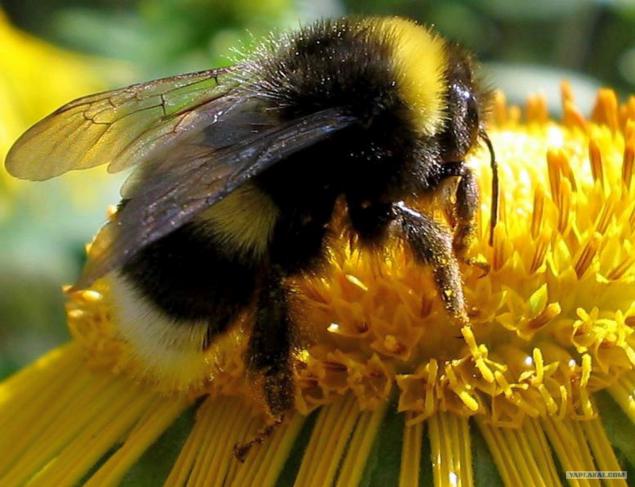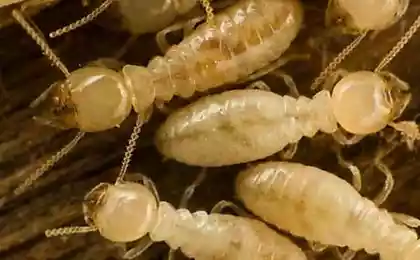1571
Cold-resistant bees
Bumblebees (lat. Bombus) - genus of Hymenoptera, which are close relatives of melliferous bees. About 300 species of bumblebees live in Northern Eurasia, North America, North Africa, as well as in some other parts of the mountains.
Continued under the cut ...

Bumblebees - one of the most cold-resistant insects. They are able to quickly and often reducing the chest muscles, rapidly warm up your body to the required 40 ° C. This allows them to depart early in the morning and collect nectar first, when the air is not yet sufficiently warmed up, and gives bumblebees definite competitive advantage over other types of insects.
Helps bumblebee bask his "coat" - it reduces heat loss in half.
In flight, the 90% of the energy is converted to heat, and therefore the temperature is constant flying bumblebee 36 "C at an ambient temperature of 5 ° C and 45 ° C - 35 ° C in air. At higher temperatures, the bumblebee can not fly due to overheating. While cooling mechanisms in bumblebees are: flying bumblebee mouth produces a drop of liquid that evaporates and cools the head.
Bumblebee is not able to maintain a high body temperature when sitting still.
Bumblebee has a top speed of 18 km / h.
Bees live in colonies of 50-200 individuals in each. In the colony consists of three types of individuals: female workers (immature females) and males. The founder of the family is a female-queen, this is one of the few over-wintered in the fall fertilized females. Early spring (late April-May) in the uterus starts to arrange the nest alone.
Bumblebees feature is that, unlike other public bee larva develops and all are fed together in the same chamber. Under normal conditions, female, putting 200-400 eggs that give workers begins to lay eggs, which give rise to males and females.
A long time ago it was observed that in a hornet's nest before dawn appears "trumpeter", which was thought to raise buzz fellow to work. But it turned out that he was just shivering from the cold. Indeed, in the early morning hours the temperature at the soil surface drops sharply. Socket and cooled in order to warm it, bees have to work hard pectoral muscles.
On hot days, you can see the Bumblebee at the entrance to the nest that flutters its wings. He is engaged in ventilation slot.
Do bumblebees, as well as that of bees, is a poison, but, unlike bees, bumblebees sting in human skin is left. A bruise, respectively, can many times.
Separate relatives bumblebees called Psithyrus different parasitic way of life, they enclose their larvae in the hive other bumblebees, and in addition they imitate the color.
There is a common misconception that the bumblebee flies contrary to the laws of aerodynamics. It probably originated in the beginning of the XX century when attempting to apply to the calculation of bumblebee lift designed for aircraft. Zheng physicist Jane Wang of Cornell University (USA) has shown that flying insect does not violate the laws of physics. It took many hours on a supercomputer simulation of complex motion of air around a fast-moving wings. Wang notes that the old myth of the bumblebee - simply a consequence of poor understanding aeronautical engineer nonstationary viscous gas dynamics.
Because of the low aggressiveness of bees they can be widely used in the garden and suburban areas. There is even a branch of such called shmelevodstvo - breeding bees for pollination of crops in order to increase their productivity.
The words of the famous song "Shaggy bumblebee" from the movie "Cruel Romance" is a very free adaptation of Rudyard Kipling's poem The Gipsy Trail («Gypsy Trail"), published in the magazine The Century for December 1892. By the way once Dmitry Medvedev, even without being president of the Russian Federation, performed this song at the wedding of a friend, dressed Gypsy in gratitude for what was nicknamed "Bumblebee".
Source.

Continued under the cut ...

Bumblebees - one of the most cold-resistant insects. They are able to quickly and often reducing the chest muscles, rapidly warm up your body to the required 40 ° C. This allows them to depart early in the morning and collect nectar first, when the air is not yet sufficiently warmed up, and gives bumblebees definite competitive advantage over other types of insects.
Helps bumblebee bask his "coat" - it reduces heat loss in half.
In flight, the 90% of the energy is converted to heat, and therefore the temperature is constant flying bumblebee 36 "C at an ambient temperature of 5 ° C and 45 ° C - 35 ° C in air. At higher temperatures, the bumblebee can not fly due to overheating. While cooling mechanisms in bumblebees are: flying bumblebee mouth produces a drop of liquid that evaporates and cools the head.
Bumblebee is not able to maintain a high body temperature when sitting still.
Bumblebee has a top speed of 18 km / h.
Bees live in colonies of 50-200 individuals in each. In the colony consists of three types of individuals: female workers (immature females) and males. The founder of the family is a female-queen, this is one of the few over-wintered in the fall fertilized females. Early spring (late April-May) in the uterus starts to arrange the nest alone.
Bumblebees feature is that, unlike other public bee larva develops and all are fed together in the same chamber. Under normal conditions, female, putting 200-400 eggs that give workers begins to lay eggs, which give rise to males and females.
A long time ago it was observed that in a hornet's nest before dawn appears "trumpeter", which was thought to raise buzz fellow to work. But it turned out that he was just shivering from the cold. Indeed, in the early morning hours the temperature at the soil surface drops sharply. Socket and cooled in order to warm it, bees have to work hard pectoral muscles.
On hot days, you can see the Bumblebee at the entrance to the nest that flutters its wings. He is engaged in ventilation slot.
Do bumblebees, as well as that of bees, is a poison, but, unlike bees, bumblebees sting in human skin is left. A bruise, respectively, can many times.
Separate relatives bumblebees called Psithyrus different parasitic way of life, they enclose their larvae in the hive other bumblebees, and in addition they imitate the color.
There is a common misconception that the bumblebee flies contrary to the laws of aerodynamics. It probably originated in the beginning of the XX century when attempting to apply to the calculation of bumblebee lift designed for aircraft. Zheng physicist Jane Wang of Cornell University (USA) has shown that flying insect does not violate the laws of physics. It took many hours on a supercomputer simulation of complex motion of air around a fast-moving wings. Wang notes that the old myth of the bumblebee - simply a consequence of poor understanding aeronautical engineer nonstationary viscous gas dynamics.
Because of the low aggressiveness of bees they can be widely used in the garden and suburban areas. There is even a branch of such called shmelevodstvo - breeding bees for pollination of crops in order to increase their productivity.
The words of the famous song "Shaggy bumblebee" from the movie "Cruel Romance" is a very free adaptation of Rudyard Kipling's poem The Gipsy Trail («Gypsy Trail"), published in the magazine The Century for December 1892. By the way once Dmitry Medvedev, even without being president of the Russian Federation, performed this song at the wedding of a friend, dressed Gypsy in gratitude for what was nicknamed "Bumblebee".
Source.
























